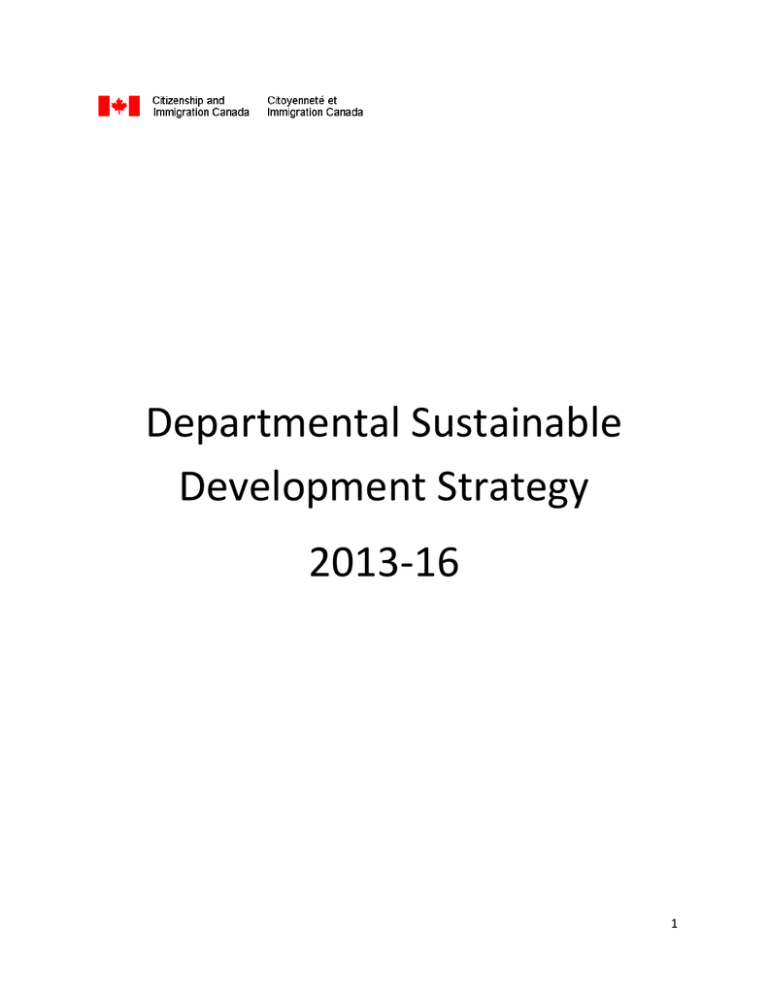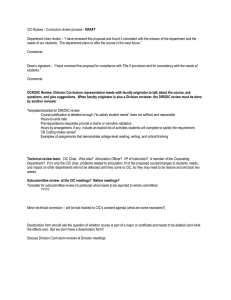2013-16 Departmental Sustainable Development Strategy
advertisement

Departmental Sustainable Development Strategy 2013-16 1 Overview of the Federal Government’s Approach to Sustainable Development The 2013-2016 Federal Sustainable Development Strategy (FSDS), tabled on November 4, 2013, guides the Government of Canada’s 2013-2016 sustainable development activities. The FSDS articulates Canada’s federal sustainable development priorities for a period of three years, as required by the Federal Sustainable Development Act (FSDA), approved in 2008. The purpose of the FSDA is to provide the legal framework for developing and implementing a federal sustainable development strategy that will make environmental decision-making more transparent and accountable to Parliament. Citizenship and Immigration Canada supports the implementation of the FSDS through the activities found in this departmental strategy. This Departmental Sustainable Development Strategy (DSDS) aligns with the FSDS to ensure that CIC programs, policies and services are developed in accordance with the basic principles of sustainable development and that CIC operations are conducted in an environmentally responsible manner. CIC contributes to Theme IV- Shrinking the Environmental Footprint- Beginning with Government of FSDS 2013-2016 under the targets 7.2 and 7.3. Sustainable Development Management System CIC’s mandate comes from the Department of Citizenship and Immigration Act. The Minister for Citizenship and Immigration Canada is responsible for the Citizenship Act of 1977 and shares responsibility with the Minister of Public Safety for the Immigration and Refugee Protection Act (IRPA). In October 2008, responsibility for administering the Canadian Multiculturalism Act moved from the Department of Canadian Heritage to CIC. Jurisdiction over immigration is shared between the federal, provincial and territorial governments under section 95 of the Constitution Act, 1867. Effective July 2, 2013, primary responsibility for Passport Canada and the administration of the Canadian Passport Order and the Order Respecting the Issuance of Diplomatic and Special Passports moved from the Department of Foreign Affairs and International Trade to Citizenship and Immigration Canada. In addition as of August 31, the International Experience Canada program also moved to CIC. CIC’s VISION A stronger Canada—a safe and secure country with a shared bond of citizenship and values; a country that continues to support our humanitarian tradition and draws the best from the world to help build a nation that is economically, socially and culturally prosperous. 2 CIC's sustainable development vision was introduced in the first DSDS, with the objective of considering the economic, social and environmental considerations systematically in the departmental decision making process. CIC’s VISION for Sustainable Development In contributing to Canada’s economic, social and cultural development through migration and its global humanitarian efforts, CIC embraces an approach to sustainable development that: Promotes the responsible management of natural resources, sustainable economic practices and healthy communities through education and awareness building; Fosters individual participation in corporate initiatives through the promotion of best practices; and Is concrete, focused and results-based. Mechanisms in Place The Department's framework for managing sustainable development facilitates the integration of sustainable development into our daily activities. CIC has implemented an approach to managing sustainable development based on three major pillars: Sustainable Development Policy Framework: Effective as of November 4, 2013, and valid for a period of 3 years, the purpose of this framework is to bring together the full suite of relevant sustainable development policy instruments; to strengthen the clarity of requirements and associated roles and responsibilities; and to enhance effective monitoring and support so that CIC can better fulfill its sustainable development commitments. Policy on Sustainable Development Assessments: Effective as of November 4, 2013, the purpose of this policy is to make clear the requirements, roles and responsibilities within CIC to fulfil our obligations under the Federal Sustainable Development Act and the Cabinet Directive on the Environmental Assessment of Policy, Plan and Program Proposals (Cabinet Directive). It is the policy of CIC to ensure that its decisions are sustainable. Departmental Sustainable Development Strategy: To identify and communicate Departmental commitments expressed in terms of goals, targets and implementation strategies, which determine the sustainable development direction for a three-year cycle. 3 Governance To complement the mechanisms in place, CIC’s Sustainable Development Policy Framework and Policy on Sustainable Development Assessments (SDAs) create a governance structure to support and implement its sustainable development commitments. This structure engages all levels within the department and identifies the accountabilities, roles and responsibilities for sustainable development within the department. Executive Committee (ExCom) approves the DSDS, the Framework and internal policy instruments. Management Accountability Committee (MAC) is responsible for providing oversight for the Sustainable Development Policy Framework and its implementation. Assistant Deputy Minister, Corporate Services, is the functional lead at CIC for Sustainable Development, ensuring CIC implements the principles of SD and reports annually on plans & progress of the DSDS. The Champion of Sustainable Development plays an important supportive role, demonstrating leadership and guidance on SD as well as increasing employee awareness of the SD commitments of the department. Assistant Deputy Ministers are responsible for the application of the Sustainable Development Policy Framework within their sectors. The Director General (DG), Corporate Affairs, is the functional authority for the Policy on SDAs and is responsible for ensuring that there is governance in place regarding SDAs, that SDA requirements are clearly understood, that there is a compliance regime in effect, and that support mechanisms are developed and communicated. The Director General, Administration, Security & Accommodations, ensures compliance with central agency policy direction for green operations and is responsible for the development, implementation, reporting and regular modernization of the internal policies and instruments relating to green operations, should these be developed. Directors General are responsible for including the results of SDAs in their Memoranda to Cabinet (MC) and Treasury Board (TB) Submissions. Employees are responsible for maintaining an awareness of the principles of sustainable development, and for contributing to the implementation of green initiatives. They may be asked to contribute to the commitments and actions towards sustainable development in their own work area. 4 Finally, to further keep focused on its sustainable development commitments, CIC has integrated its targets as milestones in its Integrated Corporate Plan (ICP). CIC reports on its ICP on a quarterly basis to senior management. In addition, CIC reports publicly on its sustainable development targets through the Report on Plans and Priorities as well as the Departmental Performance Report. Strategic Environmental Assessment The Cabinet Directive requires Departments and Agencies to conduct a strategic environmental assessment for policy plan or program proposals (“Proposals”) submitted to an individual minister or to Cabinet for approval. Departments must also consider the impacts of their Proposals on the FSDS goals and targets. The Guidelines for Implementing the Cabinet Directive were revised in October 2010. Following this revision, CIC updated its internal Policy on Sustainable Development Assessments in order to comply. Under this new CIC Policy, a requirement for a Sustainable Development Assessment (SDA) was introduced. It aimed to provide a holistic assessment, balancing economic and social considerations, intergenerational equity and environmental impacts. It is primarily about integrated decision-making that maximizes the effectiveness of our policies and programs. This was a level of analysis above the strategic environmental assessment requirements under the Cabinet Directive. CIC was commended on its SDA by the Commissioner of the Environment and Sustainable Development as a “good practice” following its 2014 audit. To strengthen the application of strategic environmental assessment within the department, in 2013 CIC introduced a new risk-based triage, the SD Preliminary Scan Tool. Through a quick assessment based on ‘yes’ or ‘no’ questions, this tool is meant to streamline the process to determine whether important environmental effects, either positive or negative, would result from the implementation of the Proposal. Currently, CIC’s strategic environmental assessment process applies to Proposals contained in Memoranda to Cabinet and Treasury Board Submissions. CIC has committed to review its processes to assess potential situations where any other proposals would be subject to the Cabinet Directive, and is currently benchmarking with other departments on their definition of “proposal” to ensure consistency. CIC uses two tools to support the application of the Cabinet Directive: The SD Preliminary Scan Tool, as discussed above, assists analysts in completing a scan of the Proposal for potential environmental effects. If the tool finds that there are potential environmental effects, either positive or negative, the next step is to complete a detailed SDA. 5 The CIC SDA Report Template is a tool to assist in completing the SDA. It sets out the four main criteria to be analysed: Financial/Economic, Environmental, Social, and General/Equity considerations. It then provides guiding questions to steer the analysis. Each criterion is assessed on a five-point scale, following which any potential environmental effects and mitigation strategies must be discussed. Once complete, the SDA Report is submitted to the Management Accountability Office (MAO) for review and must be approved by the lead DG and the DG of Corporate Affairs. To make sure that these tools are being implemented, MAO monitors CIC’s lists of MCs and TB submissions and proactively reaches out to owners to initiate the SD process. CIC also has in place a tracking mechanism to follow up on the Proposals that are outstanding and to monitor new Proposals as they are being developed. Department/Agency-led Targets CIC contributes to Canada’s human capital through immigration. As such, the Department’s programs and policies impact more directly on Canada’s economy and social fabric than on its ecosystems. Therefore, the department is not responsible for leading any targets from the Themes I-III of the 20132016 FSDS. Department/Agency Implementation Strategies CIC contributes to the FSDS targets through our Internal Services Program Activity (PA 5.1). CIC’s contributions are all under goals 6 and 7 of theme IV of the FSDS: Shrinking the Environmental Footprint – Beginning with Government. The section below details CIC’s contribution and targets under the goals for greenhouse gas emissions, electronic and electrical waste, printing unit reduction, paper consumption, green meetings and green procurement. FSDS 2013-2016 Goal FSDS 2013-2016 Target Performance Indicator Goal 6: Greenhouse Gas (GHG) Emissions and Energy 6.1- Reduce CIC’s GHG emissions from its vehicle fleet by 17% below 2005-2006 levels by 20202021. CIC’s GHG emission reduction relative to fiscal year 2005-06, expressed as a percentage. Goal 7: Waste and Asset Management 7.2- Embed environmental considerations into public Number and percentage of specialists in procurement 6 FSDS 2013-2016 Goal FSDS 2013-2016 Target Performance Indicator procurement, in accordance with the federal Policy on Green Procurement. and/or materiel management who have completed the Canada School of Public Service Green Procurement course (C215) or equivalent in the given fiscal year. Number and percentage of managers and functional heads of procurement and materiel management whose performance evaluation includes environmental considerations, support and contribution toward green procurement in the given fiscal year. Target 7.3- Update and adopt policies and practices to improve the sustainability of CIC’s workplace operations based on the following targets. Implement an approach to maintain or improve the sustainability of the departmental workplace by March 31, 2015: A) Disposal of Electronic/Electrical Equipment (EEE) through recycling or reuse, following PWGSC EEE protocols. Target level: 95%. A) Percentage of all EEE products per year that have been disposed of according to PWGSC protocols. B) Reduce printing units: Target of 8 employees per printer (8:1). B) Ratio of printing units per employee. C) Reduce, maintain or exceed paper consumption by 20% from 2010-2011 baseline of 5996 sheets per employee. C) Number of sheets of paper per employee at the end of the given fiscal year. 7 Greening Government Operations Supplementary Table Please use the link below to visit the departmental Greening Government Operations (GGO) Supplementary Table, found in Section III of the 2014-15 RPP for more information on CIC’s departmental strategies for Greening Government Operations Targets. http://www.cic.gc.ca/english/resources/publications/rpp/2014-2015/supplementary-tables.asp#a4 Please use the link below to visit the departmental Greening Government Operations (GGO) Operations Table, found in the latest Departmental Performance Report (DPR) for more information on CIC’s GGO targets and performance measures under the FSDS. http://www.cic.gc.ca/english/resources/publications/dpr/2013/03.asp Useful Links For more information on Greening Government Operations, please visit the website of the Office of Greening Government Operations: http://www.tpsgc-pwgsc.gc.ca/ecologisation-greening/index-eng.html For more information on Strategic Environmental Assessment, please visit the website of the Canadian Environmental Assessment Agency: https://www.ceaa-acee.gc.ca/default.asp?lang=En&n=A4C57835-1 8





